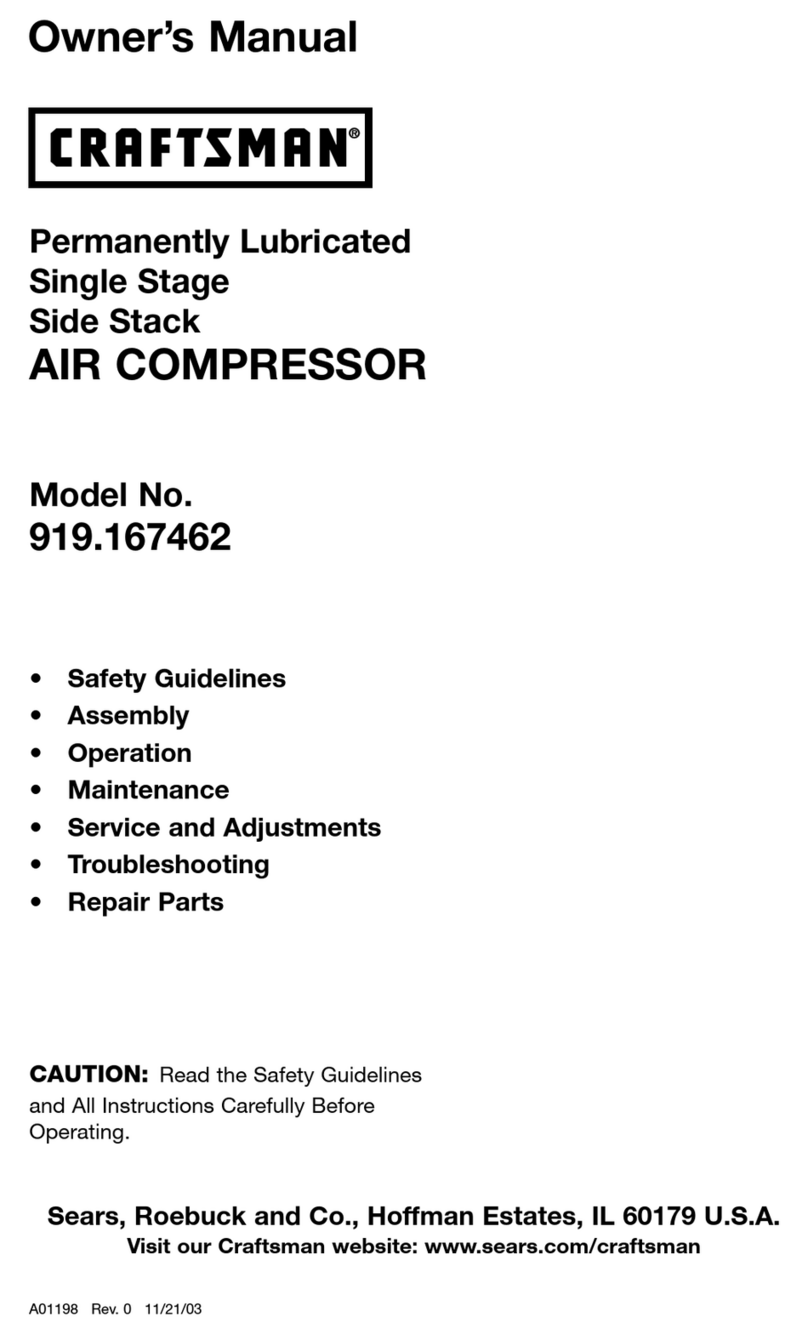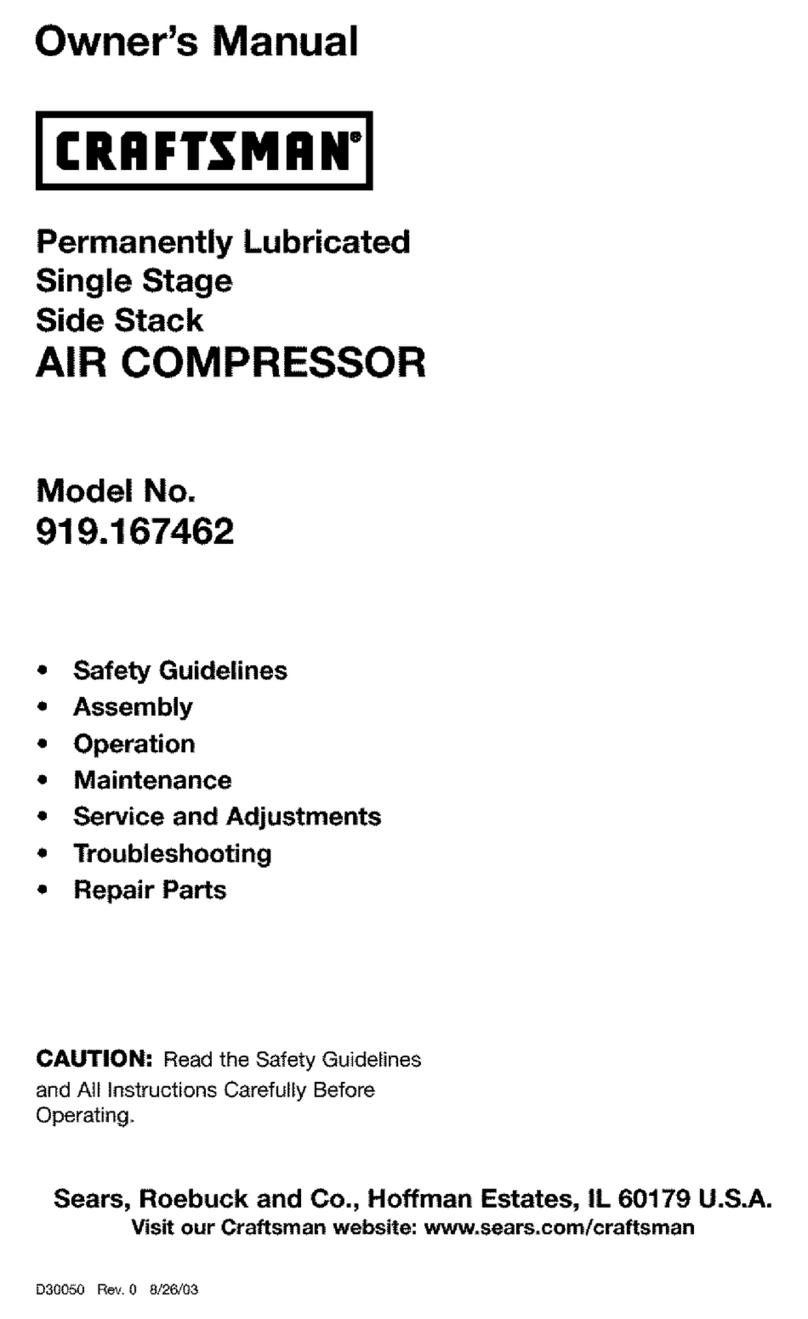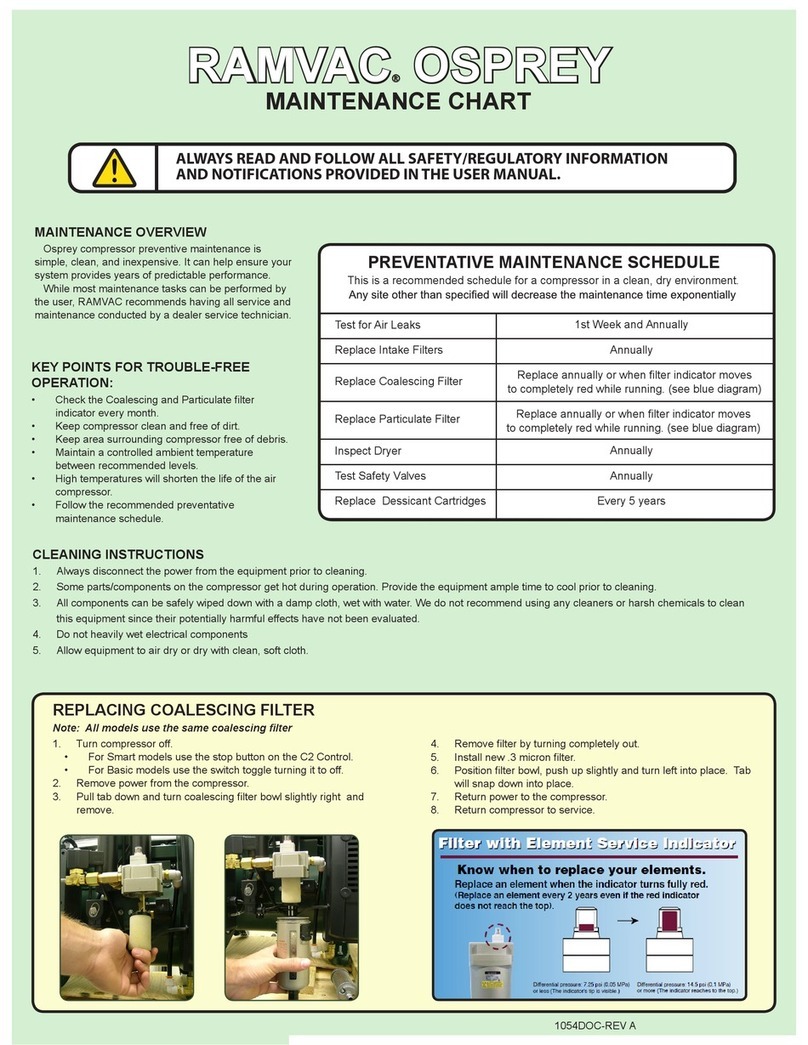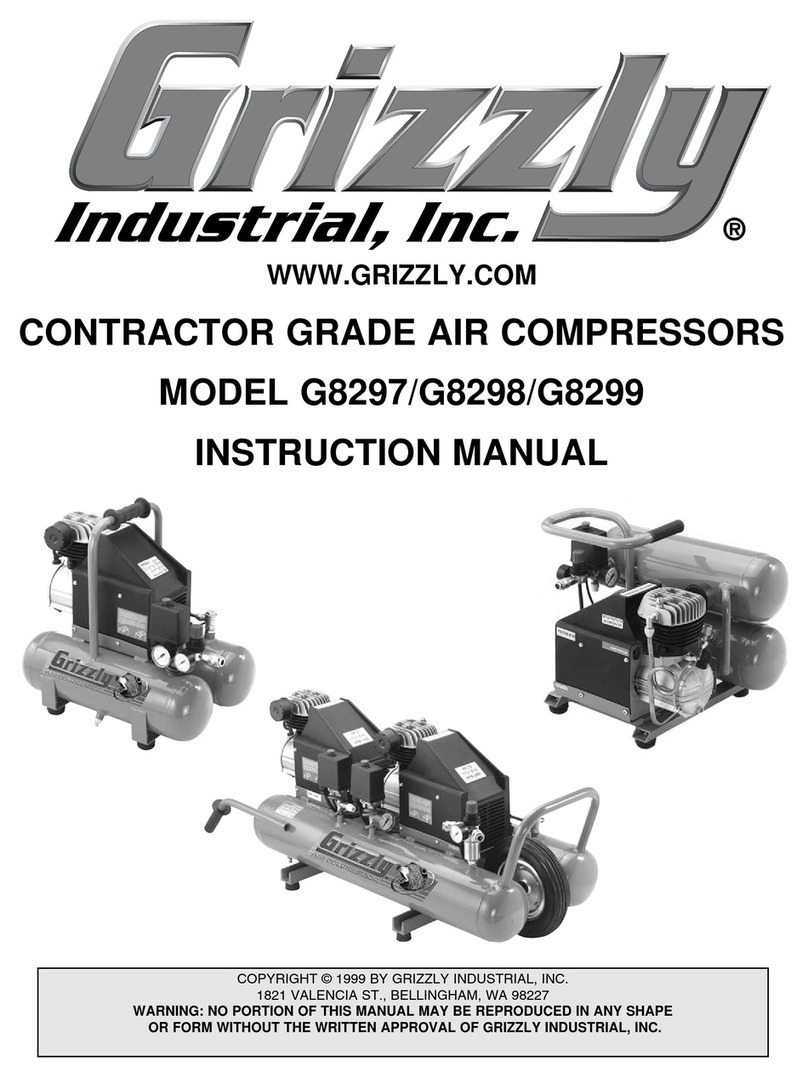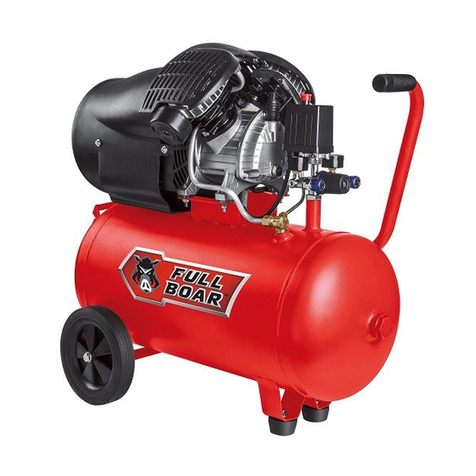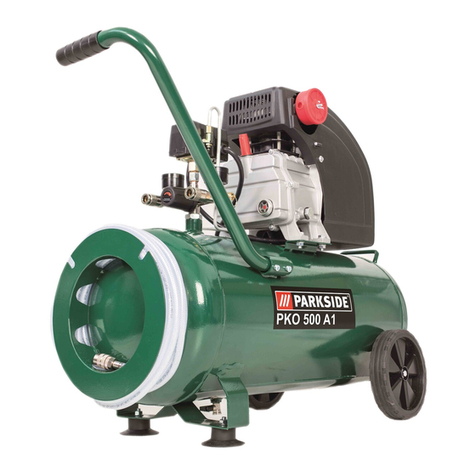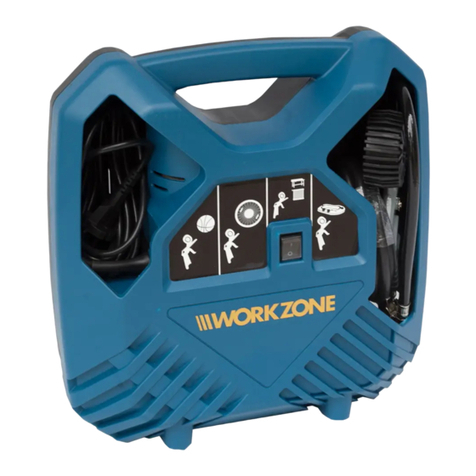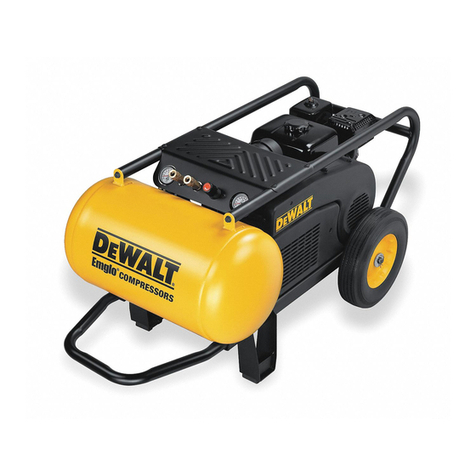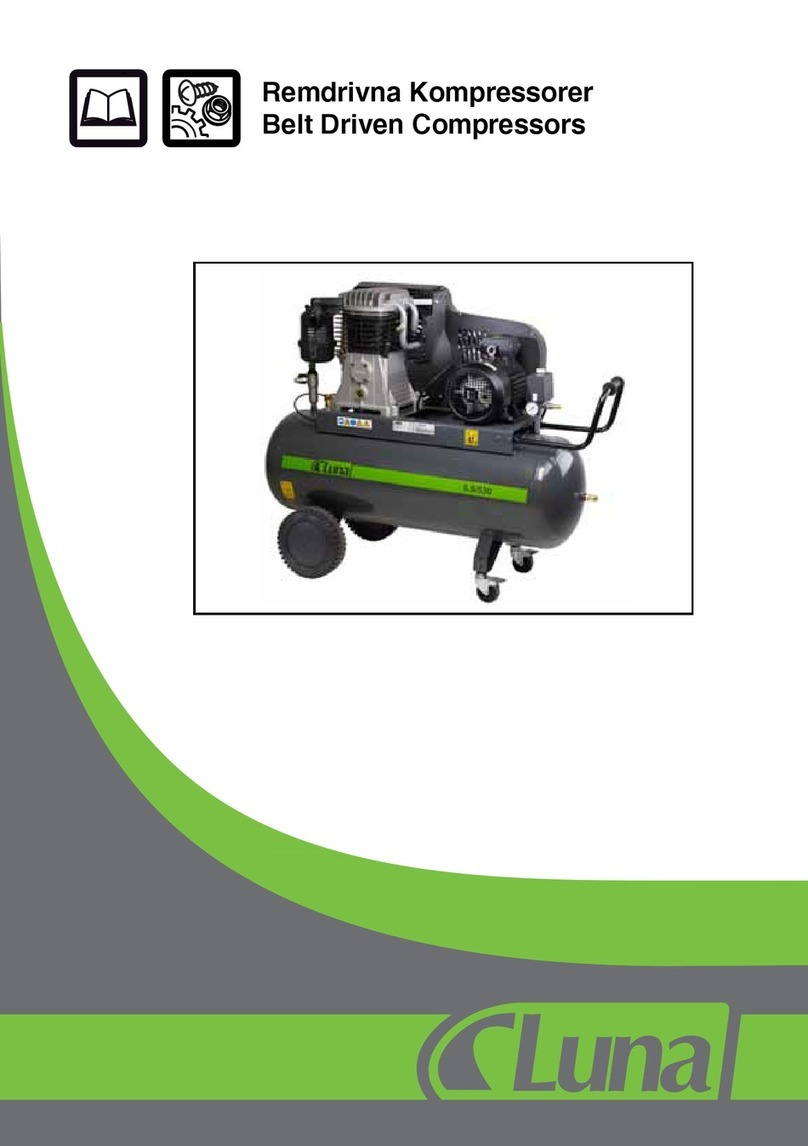Hitachi Koki EC 189 Operator's manual

EC 189
INSTRUCTION MANUAL AND SAFETY INSTRUCTIONS FOR AIR COMPRESSOR
MANUEL D’UTILISATION ET CONSIGNES DE SÉCURITÉ DU COMPRESSEUR
MANUAL DE INSTRUCCIONES Y INSTRUCCIONES DE SEGURIDAD PARA EL COMPRESOR DE AIRE
MODEL
MODÈLE
MODELO
WARNING
Improper and unsafe use of this compressor can result in death or serious bodily injury!
This manual contains important information about product safety.
Please read and understand this manual before operating the compressor.
Please keep this manual available for others before they use the compressor.
AVERTISSEMENT
Une utilisation du compresseur de manière incorrecte ou ne respectant pas les consignes de sécurité peut entraîner la
mort ou de graves blessures !
Ce manuel renferme des informations importantes relatives à la sécurité.
Veuillez lire attentivement toutes les instructions avant de mettre le compresseur en service.
Laissez ce manuel à la disposition des personnes qui vont utiliser le compresseur.
ADVERTENCIA
¡La utilización inadecuada e insegura de este compresor puede resultar en la muerte o en lesiones serias!
Este manual contiene información importante sobre la seguridad del producto.
Antes de utilizar el compresor, lea y entienda bien este manual.
Guarde este manual a disposición para que otras personas puedan leerlo antes de utilizar el compresor.
e_ec189_e.p65 11/6/03, 2:23 PM1

CONTENTS
English
IMPORTANT INFORMATION ........................................... 3
MEANINGS OF SIGNAL WORDS .....................................3
SAFETY
IMPORTANT SAFETY INSTRUCTIONS
FOR USE OF THE COMPRESSOR ..............................4
REPLACEMENT PARTS .................................................... 6
GROUNDING INSTRUCTIONS .........................................7
OPERATION AND MAINTENANCE
NAME OF PARTS ............................................................. 8
SPECIFICATIONS ...............................................................9
APPLICATIONS ................................................................. 9
PRIOR TO OPERATION .................................................... 9
TRANSPORT ....................................................................11
OPERATION .....................................................................11
MAINTENANCE ...............................................................12
SERVICE AND REPAIRS ..................................................14
PARTS LIST ......................................................................40
Page Page
TABLE DES MATIÈRES
Français
INFORMATIONS IMPORTANTES ...................................15
SIGNIFICATION DU VOCABULAIRE
DE SIGNALISATION ..................................................15
SÉCURITÉ
CONSIGNES DE SÉCURITÉ IMPORTANTES
POUR L’UTILISATION DU COMPRESSEUR ............16
PIÈCES DE RECHANGE ...................................................18
INSTRUCTIONS DE MISE À LA TERRE .........................19
UTILISATION ET ENTRETIEN
NOM DES PIÈCES ...........................................................20
SPECIFICATIONS .............................................................21
APPLICATIONS ................................................................21
AVANT L’UTILISATION ...................................................21
TRANSPORT ....................................................................23
UTILISATION ...................................................................23
ENTRETIEN ......................................................................25
SERVICE APRÈS-VENTE ET RÉPARATIONS .................26
LISTE DES PIÈCES ...........................................................40
Page Page
ÍNDICE
Español
INFORMACIÓN IMPORTANTE .......................................27
SIGNIFICADO DE LAS PALABRAS DE
SEÑALIZACIÓN .........................................................27
SEGURIDAD
INSTRUCCIONES IMPORTANTES DE SEGURIDAD
PARA LA UTILIZACIÓN DEL COMPRESOR .............28
PIEZAS DE REEMPLAZO .................................................30
INSTRUCCIONES PARA LA PUESTA A TIERRA ...........31
OPERACIÓN Y MANTENIMIENTO
NOMENCLATURA ...........................................................32
ESPECIFICACIONES ........................................................33
APLICACIONES ................................................................33
ANTES DE LA OPERACIÓN ............................................33
TRANSPORTE ..................................................................35
OPERACIÓN .....................................................................35
MANTENIMIENTO ...........................................................37
SERVICIO Y REPARACIONES .........................................38
LISTA DE PIEZAS ............................................................40
Página Página
e_ec189_e.p65 11/6/03, 2:23 PM2

—3 —
English
IMPORTANT INFORMATION
Read and understand all of the operating instructions, safety precautions and warnings in the Instruction Manual before
operating or maintaining this compressor.
Most accidents that result from compressor operation and maintenance are caused by the failure to observe basic safety
rules or precautions. An accident can often be avoided by recognizing a potentially hazardous situation before it occurs,
and by observing appropriate safety procedures.
Basic safety precautions are outlined in the “SAFETY”section of this Instruction Manual and in the sections which contain
the operation and maintenance instructions.
Hazards that must be avoided to prevent bodily injury or machine damage are identified by WARNINGS on the compressor
and in this Instruction Manual.
Never use this compressor in a manner that has not been specifically recommended by HITACHI, unless you first confirm
that the planned use will be safe for you and others.
MEANINGS OF SIGNAL WORDS
WARNING indicates a potentially hazardous situations which, if ignored, could result in death or serious injury.
CAUTION indicates a potentially hazardous situations which, if not avoided, may result in minor or moderate injury, or
may cause machine damage.
NOTE emphasizes essential information.
e_ec189_e.p65 11/6/03, 2:23 PM3

—4 —
English
SAFETY
IMPORTANT SAFETY INSTRUCTIONS
FOR USE OF THE COMPRESSOR
WARNING: Death or serious bodily injury could result from improper or unsafe use of this compressor.
To avoid these risks, follow these basic safety instructions.
READ ALL INSTRUCTIONS
7. STORE COMPRESSOR PROPERLY.
When not in use, this compressor should be stored in
indoor dry place. Keep out of reach of children. Lock-
out the storage area.
8. KEEP WORK AREA CLEAN.
Cluttered areas invite injuries. Always clear all work
areas of unnecessary tools, debris, furniture, etc.
9. CONSIDER WORK AREA ENVIRONMENT.
Risk of electric shock. Don’t expose this compressor to
rain. Don’t use this compressor in damp or wet
locations.
Risk of fire or explosion. Keep work area well lit and
well ventilated. Always operate air compressor in a
well ventilated area free of flammable vapors,
combustible dust, gases or other combustible
materials. Do not carry and operate the compressor or
any other electrical device near the spray area. Don’t
use compressor in the presence of flammable liquids
or gases.
Compressor produces sparks during operation. Never
use compressor in sites containing lacquer, paint,
benzine, thinner, gasoline, gases, adhesive agents,
and other materials which are combustible or
explosive. Do not smoke if spraying flammable
material. Locate the air compressor at least 20 feet
(6 m) away from the spray area. (An additional hose
may be required.)
Never place objects against or on top of air
compressor. Operate air compressor at least 12 inches
(30 cm) away from any wall or obstruction that would
restrict proper ventilation.
In order to avoid damaging this compressor, do not
allow the unit to be tilted more than 10°when
operating.
10. KEEP VISITORS AWAY.
Do not let visitors contact compressor extension cord.
All visitors should be kept safely away from work
area.
11. DRESS PROPERLY.
Do not wear loose clothing or jewelry. They can be
caught in moving parts.
Wear protective hair covering to contain long hair.
12. DON’T ABUSE CORD.
Never yank it to disconnect from receptacle.
Keep cord from heat, oil and sharp edges.
13. MAINTAIN COMPRESSOR WITH CARE.
Follow instructions for lubricating.
Inspect cords periodically and if damaged, have
repaired by authorized service center. Inspect
extension cords periodically and replace if damaged.
1. NEVER TOUCH MOVING PARTS.
Never place your hands, fingers or other body parts
near this compressor’s moving parts.
Never insert your fingers or other objects into the
housing’s ventilator. Such an action invites the danger
of injuries or electric shocks.
2. NEVER OPERATE WITHOUT ALL GUARDS IN PLACE.
Never operate this compressor without any guards or
safety features in place and in proper working
condition. Always unplug the air compressor before
removing any guard. Replace damaged covers/guards
before using the air compressor. If maintenance or
servicing requires the removal of guard or safety
features, be sure to replace the guard or safety
features before resuming operation of this compressor.
3. ALWAYS WEAR PROTECTION.
Risk of injury. Always wear ANSI Z87.1 safety glasses
or equivalent eye protection. Compressed air must
never be aimed at anyone or any part of the body. Use
ear protection as air flow noise is loud when draining.
4. PROTECT YOURSELF AGAINST ELECTRIC SHOCK.
Don’t expose this compressor to rain. Never operate
this compressor in damp or wet locations.
Make sure the air compressor is plugged into a
properly grounded outlet which provides correct
voltage and adequate fuse protection. Disconnect
when not in use.
Check power cord for signs of crushing, cutting or
heat damage. Replace faulty cord before use.
Keep all connections dry and off the ground. Do not
allow electrical cords to lay in water or in such a
position where water could come in contact with
them. Do not touch plug with wet hands. Do not pull
on the electrical cord to disconnect from the outlet.
Any electrical wiring or repairs performed on this air
compressor should be done by Authorized Service
Personnel in accordance with National and Local
electrical codes.
To reduce risk of electric shock, do not remove cover.
5. SHUT DOWN THE AIR COMPRESSOR
Before servicing, inspecting, maintaining, cleaning,
replacing or checking any parts, always to stop the air
compressor, relieve pressure and unplug the air
compressor from the power source.
6. AVOID UNINTENTIONAL STARTING.
Do not carry the compressor while it is connected to
its power source or when the air tank is filled with
compressed air. Be sure the knob of the motor/
pressure switch in the “OFF”position before
connecting the compressor to its power source.
e_ec189_e.p65 11/6/03, 2:23 PM4

—5 —
English
14. OUTDOOR USE EXTENSION CORDS.
When compressor in used outdoors, use only
extension cords intended for use outdoors and so
marked.
15. STAY ALERT.
Watch what you are doing. Use common sense. Do
not operate this compressor when you are tired. This
compressor should never be used by you if you are
under the influence of alcohol, drugs or medication
that makes you drowsy. Know how to stop the air
compressor. Be thoroughly familiar with controls.
16. CHECK DAMAGED PARTS AND AIR LEAK.
Before further use of this compressor, guard or other
parts should be carefully checked to see that it will
operate properly and perform its intended function.
Check alignment of moving parts, binding of moving
parts, breakage of parts, mounting, air leak, and any
other conditions that may affect its operation.
A guard or other part that is damaged should be
properly repaired or replaced by an authorized service
center unless otherwise indicated elsewhere in this
Instruction Manual.
Have defective motor/pressure switches replaced by
authorized service center.
Do not use this compressor if motor/pressure switch
does not turn it “AUTO/OFF.”
17. NEVER USE THIS COMPRESSOR FOR APPLICATIONS
OTHER THAN THOSE SPECIFIED.
Never use this compressor for applications other than
those specified in the Instruction Manual.
Never use compressed air for breathing or respiration.
Operate air compressor only in a well ventilated area.
Follow all safety instructions provided with the
materials you are spraying. Use of a respirator may be
required when working with some materials.
18. HANDLE THIS COMPRESSOR CORRECTLY.
Operate this compressor according to the instructions
provided herein. Never allow this compressor to be
operated by children, individuals unfamiliar with its
operation or unauthorized personnel. Do not operate
air compressor without a filter element. Do not
operate air compressor in a corrosive environment.
Always operate the air compressor in a stable, secure
position to prevent air compressor from falling. Follow
all maintenance instructions listed in this manual.
19. KEEP ALL SCREWS, BOLTS AND COVERS TIGHTLY IN
PLACE.
Keep all screws, bolts, and covers tightly mounted.
Check their conditions periodically.
20. KEEP MOTOR AIR VENT CLEAN.
The motor air vent must be kept clean so that air can
freely flow at all times. Check for dust build-up
frequently.
21. OPERATE COMPRESSOR AT THE RATED VOLTAGE.
Operate the compressor at voltages specified on their
nameplates.
If using the compressor at a higher voltage than the
rated voltage, it will result in abnormally fast motor
revolution and may damage the unit and burn out the
motor.
22. NEVER USE A COMPRESSOR WHICH IS DEFECTIVE
OR OPERATING ABNORMALLY.
If this compressor appears to be operating unusually,
making strange noises or vibration, or otherwise
appears defective, stop using it immediately and
arrange for repairs by a Hitachi authorized service
center.
23. DO NOT WIPE PLASTIC PARTS WITH SOLVENT.
Solvents such as gasoline, thinner, benzine, carbon
tetrachloride, and alcohol may damage and crack
plastic parts. Do not wipe plastic parts on this
compressor with such solvents. Wipe plastic parts
with a soft cloth lightly dampened with soapy water
and dry thoroughly.
24. USE ONLY GENUINE HITACHI REPLACEMENT PARTS.
Replacement parts not manufactured by Hitachi may
void your warranty and can lead to malfunction,
causing injuries. Genuine Hitachi parts are available
from your dealer.
25. DO NOT MODIFY THIS COMPRESSOR.
Do not modify this compressor.
Do not operate at pressure or speed in excess of
manufacturer’s recommendations.
Always contact the Hitachi authorized service center
for any repairs. Unauthorized modification may impair
this compressor’s performance and result in accident
or bodily injury to repair personnel who do not have
the required knowledge and technical expertise to
perform the repair operations correctly. If air tank
develops a leak, replace the air tank immediately.
Never repair, weld or make modifications to the air
tank or its attachments.
Use only genuine Manufacturer repair parts for your
air compressor.
Never make adjustments to the factory set pressures.
Never exceed manufacturers maximum allowable
pressure rating of attachments.
Because of extreme heat, do not use plastic pipe or
lead tin soldered joints for a discharge line.
26. TURN OFF THE MOTOR/PRESSURE SWITCH WHEN
THIS COMPRESSOR IS NOT USED.
When this compressor is not used, make sure the
motor/pressure switch is in the OFF position and open
the drain valve to discharge the compressed air from
the air tank.
27. NEVER TOUCH HOT SURFACE.
To reduce the risk of burns, never allow any part of
your body or other materials to contact with any
exposed metal parts on this compressor.
Never allow any part of your body to contact the
motor or adjacent areas.
These areas can remain hot for at least 45 minutes
after this compressor is shutdown. Cool down before
servicing.
28. DO NOT DIRECT AIR STREAM AT BODY.
Risk of injury. Do not direct air stream at persons or
animals, to avoid any bodily injury.
Never use compressed air for breathing or respirators.
Never leave pressurized air in the air compressor.
Shut off air compressor and relieve pressure when
storing or attempting maintenance.
Always maintain a safe distance from people and
animals while operating the air compressor.
Do not move the air compressor while air tank is
under pressure. Do not attempt to move the air
compressor by pulling on the hose.
29. DRAIN TANK.
Risk of bursting. Water will condense in the air tank.
Discharge the drain after each use and every day.
When the air tank gets corroded, there can be a risk of
e_ec189_e.p65 11/6/03, 2:23 PM5

—6 —
English
breakdown. Accordingly, be sure to discharge the
drain inside the air tank after each use. The drain
contains moisture in the air, abrasion particles, rust,
etc. To drain the air tank open valve slowly and tilt
compressor to empty accumulated water.
To discharge the drain, therefore, gradually open the
drain valve, and be careful not to point it at your face
or eyes.
30. DO NOT STOP COMPRESSOR BY PULLING OUT THE
PLUG.
This could result in damage to the unit.
Use the “AUTO/OFF”lever of motor/pressure switch.
31. MAKE SURE THE COMPRESSOR OUTLET PRESSURE
IS SET LOWER THAN THE MAXIMUM OPERATING
PRESSURE OF THE TOOL.
Too much air pressure causes a hazardous risk of
bursting. Check the manufacturer’s maximum
pressure rating for air tools and accessories. The
regulator outlet pressure must never exceed the
maximum pressure rating.
32. THE SAFETY RELIEF VALVE MUST WORK PROPERLY.
Risk of bursting. Before starting the compressor pull
the ring on the safety relief valve to make sure the
valve moves freely. If the safety relief valve does not
work properly, over-pressurization may occur, causing
air tank rupture or an explosion.
33. USE OF THIS PRODUCT WILL EXPOSE YOU TO
CHEMICALS KNOWN TO THE STATE OF CALIFORNIA.
Use of this product will expose you to chemicals
known to the State of California to cause cancer, birth
defects and other reproductive harm. Avoid inhaling
vapors, and wash hands after using.
34. BE CAREFUL NOT TO TRIP OVER OR DROP THE
COMPRESSOR DURING TRANSPORT.
Exercise utmost caution when you carry this
compressor. If you trip over something and drop it,
there is a fear that unexpected injury may result. If
you drop this compressor or bump it against any
objects, air tank or any component parts can cause
serious deformation, damage, severe scratches and
breakdown on this compressor. If operated under
such conditions, it can result in any accidents of bodily
injuries by explosion of the air tank or explosion of
those damaged component parts.
When there is any deformation and damage on the
handle, it may drop during transport, resulting in an
accident of injury.
Before carrying this compressor, make sure the
motor/pressure switch is in the OFF position and
discharge the drain inside the air tank.
Be cautious enough to make sure that there are no
obstacles, inflammable articles, and unauthorized
people around this compressor.
REPLACEMENT PARTS
When servicing use only genuine replacement parts.
Repairs should be conducted only by a Hitachi authorized service center.
SAFETY —Continued
e_ec189_e.p65 11/6/03, 2:23 PM6

—7 —
English
GROUNDING INSTRUCTIONS
This compressor should be grounded while in use to protect the
operator from electric shock. The compressor is equipped with a
three-conductor cord and three-prong grounding type plug to fit the
proper grounding type receptacle. The green (or green and yellow)
conductor in the cord is the grounding wire. Never connect the
green (or green and yellow) wire to a live terminal. If your unit is for
use on less than 150 volts, it has a plug that looks like that shown in
sketch (A) in Figure on the right. An adapter, see sketches (B) and
(C), is available for connecting sketch (A) type plugs to two-prong
receptacles. The green-colored rigid ear, lug, or the like extending
from the adapter must be connected to a permanent ground, such
as a properly grounded outlet box.
NOTE: The grounding adaptor, sketch (C), is prohibited in Canada
by Canadian Electrical Code Part 1. Therefore, the
instructions for its use are not applicable in Canada.
We recommend that you never disassemble the compressor or try
to do any rewiring in the electrical system. Any repairs should be
performed only by HITACHI Service Centers or other qualified
service organizations. Should you be determined to make a repair
yourself, remember that the green colored wire is the “grounding”
wire. Never connect this green wire to a “live”terminal. If you
replace the plug on the power cord, be sure to connect the green
wire only to the grounding (longest) prong on a 3-prong plug.
If in doubt, call a qualified electrician and have the receptacle
checked for ground.
SAVE THESE INSTRUCTIONS
AND
MAKE THEM AVAILABLE TO
OTHER USERS OF THIS TOOL!
Ground
blade
Grounding
means (C)
Adapter
Cover of grounded
outlet box (B)
Cover of
grounded outlet
box (A)
e_ec189_e.p65 11/6/03, 2:23 PM7

—8 —
English
OPERATION AND MAINTENANCE
NOTE: The information contained in the Compressor Instruction Manual is designed to assist you in the safe operation
and maintenance of this compressor.
Some illustrations in the Compressor Instruction Manual may show details or attachments that differ from those
on your own compressor.
NAME OF PARTS
Pilot valve
Fig. 1
Switch of thermal
protector
Electric motor
Pump Belt guard cover
Air filter assembly
Pump oil dipstick
Pump oil plug
Knob of the
pressure regulator
Joint (air outlet)
Drain valve
Motor/Pressure switch
Tank pressure gauge
Safety relief valve
Air tank Outlet pressure
gauge
e_ec189_e.p65 11/6/03, 2:23 PM8

—9 —
English
SPECIFICATIONS
OIL TYPE CHART
2. Location
(1) In order to avoid damaging this compressor, do
not incline this compressor transversely or
longitudinally more than 10°.
CAUTION: In order to avoid damaging the
compressor, do not allow the unit to be
tilted more than 10°when operating.
(2) Place this compressor at least 12 inches away
from obstacles that may prevent proper
ventilation. Do not place this compressor in an
area:
䢇where there is evidence of oil or gas leaks.
䢇where flammable gas vapors or materials may
be present.
䢇where air temperatures fall below 14°F (–10°C)
or exceed 104°F (40°C).
䢇where extremely dirty air or water could be
drawn into this compressor.
3. Electrical
(1) Power source:
Ensure that the power source to be utilized
conforms to the power source requirements
specified on the product nameplate.
(2) Use of an extension cord is not recommended
because it could cause the motor to overheat. It’s
preferable to use additional air hose instead of an
extension cord.
WARNING: Improper connection of the equipment-
grounding conductor can result in a risk
of shock or electrocution. Check with a
qualified electrician or service personnel if
you are in doubt as to whether the outlet
is properly grounded. Do not use any type
Model EC189
Motor Single-Phase, Induction Motor
Power Source Single-Phase, 115V AC 60 Hz
Output Power 1.5 HP (1.1 KW)
Current 13.2A
Tank Capacity 8 gal. (30.3 ltr)
Maximum Pressure 125 PSI (8.6 bar)
at 40 PSI (2.8 bar) 7.2 CFM (204 ltr/min)
Free Air Delivery at 90 PSI (6.2 bar) 6.6 CFM (187 ltr/min)
at 100 PSI (6.9 bar) 6.5 CFM (184 ltr/min)
Lubrication Oil
APPLICATIONS
䡬Air source of the pneumatic nailer and stapler.
WARNING: Never use compressor for applications
other than compressor for pneumatic
nailer and stapler.
PRIOR TO OPERATION
1. Initial set-up
(1) Read safety warnings before setting-up this
compressor.
(2) Ensure the oil level in this compressor pump is
adequate. If the oil level is low, replenish oil
through the filling hole so that the amount of oil
will come to a point between the maximum notch
and the minimum notch on the pump oil dipstick
according to the following OIL TYPE CHART. (Fig.
2)
Fig. 2
Minimum
Maximum
Pump oil dipstick
Ambient
temperature
Non-detergent
oil
14~32 (°F) 32~68 (°F) 68~104 (°F)
–10~0 (°C) 0~20 (°C) 20~40 (°C)
SAE 10W SAE 20W SAE 30
e_ec189_e.p65 11/6/03, 2:23 PM9

—10 —
English
of adapter with this product. If repair or
replacement of the cord or plug is
necessary, do not connect the grounding
wire to either flat blade terminal. The
wire with insulation having an outer
surface that is green with or without
yellow stripes is the grounding wire.
WARNING: Avoid electrical shock hazard. Never use
this compressor with a damaged or
frayed electrical cord or extension cord.
Inspect all electrical cords regularly.
Never use in or near water or in any
environment where electric shock is
possible.
(3) If use of an extension cord is unavoidable, be sure
to use one heavy enough to carry the current your
compressor will draw. Minimum cord sizes is as
follows:
(4) Use only a 3-wire extension cord that has a
3-blade grounding plug and a 3-slot receptacle
that will accept the plug on the compressor.
(5) Examine cords before using. Do not use the
compressor if its cord is damages. Do not use a
damaged extension cord.
WARNING: Damaged cord must be replaced or
repaired.
(6) Keep cords away from heat and sharp edges. Do
not pull on a cord to disconnect a plug –grasp the
plug.
(7) Always shut off the compressor Motor/Pressure
switch before unplugging the compressor.
(8) If the power receptacle only loosely accepts the
plug, the receptacle must be repaired. Contact the
nearest electric store for repair service.
If such a faulty receptacle is used, may cause
overheating, resulting in a serious hazard.
WARNING: This product must be grounded. If there
should be a malfunction or breakdown,
grounding provides a path of least
resistance for electric current to reduce
the risk of electric shock. This product is
equipped with a cord having an
equipment-grounding conductor and a
grounding type plug. The plug must be
plugged into an appropriate outlet that is
properly installed and grounded in
accordance with all local codes and
ordinances.
WARNING: High voltage may cause personal injury or
death. Disconnect all electrical power
supplies before opening the electrical
enclosure or servicing.
4. Air coupler installation
Screw in the air coupler to the joint (Refer to Fig. 1
and Fig. 6). The screw size of the joint is 3/8”. Use an
air coupler which has the same screw size.
5. Pre-start checklist
WARNING: Do not allow the motor or Motor/
Pressure switch to come in contact with
flammable vapors, combustible dust,
gases or other combustible materials. An
electric spark may cause an explosion or
fire.
(1) The pump oil dipstick will register the amount of
oil in the pump. (Fig. 2) Oil level should be
checked on a daily basis to ensure it does not
exceed the maximum notch or does not fall below
the minimum notch on the pump oil dipstick. If the
oil level is low, replenish oil through the filling
hole so that the amount of oil will come to a point
between the maximum notch and the minimum
notch on the pump oil dipstick according to the
OIL TYPE CHART on page 9.
WARNING: Drain tank to release air pressure before
removing the pump oil dipstick.
WARNING: Make sure air vent in pump oil dipstick is
free from debris. If air vent is blocked
pressure can build in crankcase causing
damage to compressor and possible
personal injury.
(2) Remove any moisture in the air compressor air
tank. To drain the air tank, open the drain valve
slowly and tilt compressor to empty accumulated
water. Close tightly when drained.
(3) Make sure the Motor/Pressure switch is in the
“OFF”position (Fig. 3). If the plug is connected to
a receptacle while the knob is in the “AUTO”
position, the compressor will start operating
immediately and can cause serious injury.
Fig. 3
(4) Make sure the safety relief valve is working
correctly. (Fig. 4)
The safety relief valve is designed to prevent
system failures by relieving pressure from the
system when this compressed air reaches a
predetermined level. The safety relief valve is
preset by the manufacturer and must not be
modified in any way. To verify the safety relief
valve is working properly, pull on the ring. Air
Cord Length 12 AWG
Up to 25 feet 10 AWG
26 to 100 feet 8 AWG
151 to 250 feet 6 AWG
e_ec189_e.p65 11/6/03, 2:23 PM10

— 11 —
English
pressure should escape. When the ring is
released, it will reset.
Fig. 4
(5) Make sure all guards and covers are in place and
securely mounted.
TRANSPORT
Make sure the Motor/Pressure switch is in the “OFF”
position and disconnect it from the power source before
move the compressor. Transport the compressor in the
correct manner.
OPERATION
1. Start up
(1) Read safety warnings before performing
operation.
(2) Ensure the Motor/Pressure switch is in the “OFF”
position.
(3) Plug the power cord into a grounded outlet.
(4) Move the Motor/Pressure switch to the “AUTO”
position.
Dual control: Locate the adjustment knob at the top of the
pilot valve. (Fig. 5)
Fig. 5
(a) This feature allows the compressor to operate in
either the constant run or the stop/start mode of
operation. The pilot valve is used to control the
compressor when operating in the constant run
mode. The Motor/Pressure switch is used to
control the compressor when operating in the
stop/start mode. The mode of operation is
determined by the amount of time the compressor
will be required to supply air. If the demand for air
is infrequent, then the unit should be set up for
stop/start operation to minimize unnecessary run
time and to save energy. If there is a frequent or
extended demand for air, and/or the unit is located
in a remote area where access to the compressor
is difficult, the unit should be set up for constant
run to minimize the number of times the motor
must start in an hour to ensure good motor life.
(b) If you are using the compressor when the outside
air temperature (ambient temperature) is below
25°F (–4°C), use Constant Run Mode.
Never use Stop Start Mode.
(c) Stop/Start Mode
Turn it completely clockwise to the fully closed
position. This will allow the air compressor to start
building up pressure in the air tanks and stop
when correct pressure is achieved. When pressure
drops with usage, the air compressor will start
building up pressure again.
WARNING: Over tightening of this knob can cause
damage to the pilot valve.
Constant Run Mode
Turn it completely counterclockwise to the fully
open position. The air compressor is now set up
to “CONSTANTLY” build up pressure. When
pressure reaches the preset level in the air tank,
pressure will bleed through the pilot valve.
WARNING: Over loosening of this knob can cause
damage to the pilot valve.
NOTE: Unit must remain running while performing the
following adjustments.
The motor of the compressor is fitted with a
thermal protection with manual reset (push-
button), which stops the compressor when the
temperature is too high. Should this be tripped,
the compressor will restart only if reset is done.
If you notice any unusual noise or vibration, stop
the air compressor and refer to
“Troubleshooting”.
WARNING: Do not stop or start the compressor by
use of the plug. Always use “AUTO/OFF”
knob located on the Motor/Pressure
switch.
WARNING: If you notice any unusual noise or
vibration, stop this compressor.
3. Adjustment of working pressure
The air pressure coming from the air tank is controlled
by the regulator knob (Fig. 6). Turn the pressure
regulation knob clockwise to increase discharge
pressure, and counterclockwise to decrease discharge
pressure.
Safety relief valve
Pilot valve
Knob
e_ec189_e.p65 11/6/03, 2:40 PM11

—12 —
English
Fig. 6
The outlet pressure gauge indicates the air pressure
available at the outlet side of the pressure regulator.
This pressure is controlled by the pressure regulator
and is always less or equal to the air tank pressure.
The air tank pressure gauge indicates the reserve air
pressure in the air tanks.
When adjusting the pressure, check and make sure
that a pressure gauge for the tank has the pressure
level that is higher than that of the pressure to be
adjusted.
It is also imperative that you make adjustment by
slowly starting up the pressure from the level that is
lower than the pressure to be adjusted.
WARNING: Check the manufacturer’s maximum
pressure rating for nailers, staplers and
accessories. Compressor outlet pressure
must be regulated so as to never exceed
the maximum pressure rating of the
nailers, staplers and accessories.
4. Shutdown
(1) To stop the air compressor, move the Motor/
Pressure switch to the “OFF”position. Never stop
the air compressor by unplugging it from the
power source. This could result in risk of
electrocution.
(2) To drain the air tank open the drain valve slowly
and tilt compressor to empty accumulated water.
WARNING: When the air tank gets corroded, there is
a risk of breakdown. Accordingly, be sure
to discharge the drain inside the air tank
after each use.
The drain contains moisture in the air,
abrasion particles, rust, etc. To discharge
the drain, therefore, gradually open the
drain valve, and be careful not to point it
at your face or eye.
Fig. 7
(3) Allow the air compressor to cool down.
(4) Wipe the air compressor clean and store in a safe,
non-freezing area.
5. About the thermal protector
The thermal protector operates to stop the motor
when a problem such as a motor overload, etc.,
occurs. If the motor should stop during operation,
proceed as follows.
(1) Make sure the Motor/Pressure switch is in the
“OFF”position and disconnect the plug from the
receptacle. (Fig. 3)
(2) If the extension cord does not conform to the
specifications given on page 9 and 10 replace with
an extension cord such as that shown on page 9
and 10. If the capacity of the power supply is
insufficient, increase the power supply capacity to
remove the cause of a flow of excessive current
(over-current).
(3) Wait approximately 5 minutes, then press the
reset switch of the thermal protector (Fig. 8).
(4) Start up. If the motor still stops during operation,
please contact the service center.
Fig. 8
MAINTENANCE
WARNING: Never assume the air compressor is safe
to work on just because it is not
operating. It could restart at any time!
Drain valve
Air tank
Tank pressure
gauge Joint (Air outlet)
Knob of the
pressure
regulator
Decrease:
Counter clockwise
Increase: Clockwise
Outlet pressure
gauge
Switch of thermal
protector
e_ec189_e.p65 11/6/03, 2:23 PM12

—13 —
English
WARNING: Disconnect the compressor from the
power source and remove the
compressed air from the air tank before
performing the maintenance operations.
Allow the compressor to cool before
performing the maintenance operations.
Read the instruction manual before performing
maintenance. The following procedures must be
performed when stopping this compressor for
maintenance or service.
(1) Turn off this compressor.
(2) Disconnect power cord from main power supply.
(3) Open all drains.
(4) Wait for this compressor to cool down before
starting service.
1. Cleaning the filter element
This filter is designed to clean air coming into the
pump (Fig. 9). To ensure the pump continually
receives a clean, cool, dry air supply this filter must
always be clean and ventilation opening must always
be free from obstructions.
WARNING: Never clean filter element with a
flammable liquid or solvent.
CAUTION: Do not operate without the filter element.
Fig. 9
NOTE: Replace the filter element when it becomes dirty.
2. Draining air tank:
Gradually open the drain valve, and drain out the air
in the air tank. (Fig. 7)
Close tightly when drained.
3. Oil change-oil topping off
CAUTION: Overfilling with oil will cause premature
compressor failure. Do not overfill.
(1) Within the first 50 hours of operation, completely
replace the oil of the pumping element. Unfasten
the pump oil plug on the casing cover, drain all
the oil, and screw the plug back on (Refer to Fig. 1
and Fig. 10).
Fig. 10
Pour oil into the hole of the pump oil dipstick.
To the level indicated on the pump oil dipstick
(Refer to Fig. 2).
For oil replacement, follow the table below.
OIL TYPE CHART: Refer to page 9.
(2) Check the oil level of the pumping element daily.
(3) Change the oil every 200 working hours or every
3 months.
4. Belt tension
(1) Checking belt tension
(a) Allow unit to cool.
(b) Remove beltguard.
(c) Push down on belt midway between the two
pulleys.
(d) Belt deflection should be about 1/4 inch.
(e) If belt tension is significantly greater than 1/4
inch, follow adjustment procedure.
(2) Adjusting belt tension
WARNING: Use caution when rolling belt onto
flywheel as fingers can get caught
between the belt and flywheel.
(a) Loosen the nuts on all four motor mounting
bolts.
(b) Turn belt tensioner bolt at the front of the unit
clockwise until 1/4 inch deflection is noticed
between the pulleys.
(c) Tighten nuts on motor mounting bolts.
(d) Replace beltguard.
Pump
Filter housing
(Rear)
Filter
housing
(Front)
Filter element
Pump oil plug
e_ec189_e.p65 11/6/03, 2:23 PM13

—14 —
English
5. Maintenance chart:
MAINTENANCE CHART
Every 2 years, an Authorized Service Technician should
check the check valve, intake valves and delivery valves.
SERVICE AND REPAIRS
All quality compressors will eventually require servicing
or replacement of parts because of wear and tear from
normal use. To assure that only genuine replacement
parts will be used, all service and repairs must be
performed by a HITACHI AUTHORIZED SERVICE CENTER,
only.
NOTE: Specifications are subject to change without any
obligation on the part of the HITACHI.
PROCEDURE AFTER USE DAILY WEEKLY MONTHLY 200 HOURS
Check pump oil level ⳯
Oil leak inspection ⳯
Drain condensation in air tanks ⳯⳯
Inspect guards/covers ⳯
Check for unusual noise/vibration ⳯
Check for air leaks ⳯
Clean exterior of compressor ⳯
Inspect filter ⳯
Check safety relief valve ⳯
Inspect belt tension ⳯
Change pump oil ⳯
Replace filter ⳯
e_ec189_e.p65 11/6/03, 2:23 PM14

— 15 —
Français
INFORMATIONS IMPORTANTES
Lire attentivement toutes les instructions de fonctionnement, les consignes de sécurité et les mises en garde contenues
dans ce manuel avant de faire fonctionner le compresseur ou de procéder à son entretien.
La majorité des accident résultant de l’utilisation ou de l’entretien du compresseur sont dus au non respect des consignes
et règles de sécurité élémentaires. En identifiant à temps les situations potentiellement dangereuses et en observant les
consignes de sécurité appropriées, on évite bien souvent des accidents.
Les consignes élémentaires de sécurité sont décrites dans la section «SÉCURITÉ» de ce manuel ainsi que dans les sections
renfermant les instructions d’utilisation et d’entretien.
Les situations dangereuses à éviter pour prévenir tout risque de blessure grave ou de dommages de la machine sont
signalées par des AVERTISSEMENT sur le compresseur et dans el manuel d’utilisation.
Ne jamais utiliser le compresseur d’une manière autre que celles spécifiquement recommandées par HITACHI, à moins de
s’être préalablement assuré que l’utilisation envisagée ne sera dangereuse ni pour soi ni pour les autres.
SIGNIFICATION DU VOCABULAIRE DE SIGNALISATION
AVERTISSEMENT indique des situations potentiellement dangereuses qui, si elles sont ignorées, pourraient entraîner la
mort ou de sérieuses blessures.
PRÉCAUTION indique des situations dangereuses potentilles qui, si elles ne sont pas évitées, peuvent entraîner de
mineures et légères blessures ou endommager la machine.
REMARQUE met en relief des informations essentielles.
f_ec189_e.p65 11/6/03, 2:36 PM15

—16 —
Français
SÉCURITÉ
CONSIGNES DE SÉCURITÉIMPORTANTES
POUR L’UTILISATION DU COMPRESSEUR
AVERTISSEMENT : Une utilisation du compresseur de manière incorrecte ou qui ne respecte pas les consignes de
sécuritépeut entraîner la mort ou de graves blessures. Pour éviter tout danger, observer ces
consignes élémentaires de sécurité.
BIEN LIRE TOUTES LES INSTRUCTIONS
débrancher le compresseur d’air de la source
d’alimentation.
6. ÉVITER TOUTE MISE EN MARCHE ACCIDENTELLE.
Ne pas transporter le compresseur alors qu’il est
encore raccordéàsa source d’alimentation ou que le
réservoir d’air compriméest plein. Bien s’assurer que
le sélecteur de l’interrupteur barométrique se trouve
sur la position «OFF»(arrêt) avant de raccorder le
compresseur àson alimentation.
7. REMISER LE COMPRESSEUR CORRECTEMENT.
Lorsqu’on ne se sert pas du compresseur, le remiser à
l’intérieur, dans un endroit sec. Ne pas laisser
approcher les enfants. Verrouiller l’aire de remisage.
8. MAINTENIR L’AIRE DE TRAVAIL PROPRE.
Les aires encombrées favorisent les blessures.
Toujours débarrasser l’aire de travail des outils
inutiles, débris, meubles, etc.
9. TENIR COMPTE DE L’ENVIRONNEMENT DE TRAVAIL.
Risque de choc électrique. Ne pas exposer le
compresseur àla pluie. Ne pas utiliser le compresseur
dans un lieu humide ou mouillé.
Risque de feu ou d’explosion. Veiller àce que l’aire de
travail soit bien éclairée et bien ventilée. Toujours
faire fonctionner le compresseur d’air dans un lieu
bien aéré, exempt de vapeurs gazeuses inflammables,
poussière combustible, gaz et autres matériaux
combustibles. Ne pas transporter ni faire fonctionner
le compresseur ni aucun autre appareil électrique près
de la zone d’épandage. Ne pas utiliser le compresseur
en présence de liquides ou de gaz inflammables.
Le compresseur produit des étincelles pendant le
fonctionnement. Ne jamais utiliser le compresseur
dans des endroits renfermant de la laque, de la
peinture, de la benzine, des diluants, de l’essence, des
gaz, des agents adhésifs ni aucun autre matériau
combustible ou explosif. Ne pas fumer lors de
l’épandage d’un matériau inflammable. Placer le
compresseur d’air àau moins 6 mètres (20 pieds) de
la zone d’épandage. (Il faudra peut-être utiliser un
flexible supplémentaire.)
Ne jamais placer d’objets contre ni sur le compresseur
d’air. Faire fonctionner le compresseur d’air àune
distance d’au moins 30 cm (12 pouces) du mur ou de
toute obstruction susceptible d’entraver la ventilation.
Pour éviter tout dommage du compresseur, ne pas
l’incliner àplus de 10°pendant l’utilisation.
Pour éviter d’endommager le compresseur, ne pas
l’incliner de plus de 10°pendant le fonctionnement.
10. ELOIGNER LES VISITEURS.
Ne pas laisser les visiteurs toucher le cordon de
rallonge. Eloigner suffisamment tous les visiteurs de
l’aire de travail.
1. NE JAMAIS TOUCHER LES PIECES EN MOUVEMENT.
Ne jamais approcher la main, les doigts ni aucune
autre partie du corps des pièces en mouvement du
compresseur.
Ne jamais insérer les doigts ni aucun autre objet dans
le ventilateur du logement. Cela poserait un risque de
blessures ou de choc électrique.
2. NE JAMAIS FAIRE FONCTIONNER SANS LES
PROTECTIONS.
Ne jamais faire fonctionner ce compresseur si les
protections et les dispositifs de sécuriténe sont pas
tous montés et en bon ordre de marche. Toujours
débrancher le compresseur d’air avant de retirer une
protection. Remplacer les carters/protections
endommagés avant d’utiliser le compresseur d’air. Si
l’entretien ou les réparations nécessitent le retrait
d’une protection ou d’un dispositif de sécurité, bien
remonter la protection ou le dispositif de sécurité
avant de réutiliser le compresseur.
3. TOUJOURS PORTER DES PROTECTEURS.
Risque de blessures. Toujours porter des lunettes de
protection ANSI Z87.1 ou une protection des yeux
équivalente. Ne jamais diriger le compresseur d’air
sur quelqu’un ni sur aucun partie du corps. Utiliser
une protection anti-bruit car le flux d’air fait beaucoup
de bruit pendant la vidange.
4. SE PROTEGER CONTRE LES CHOCS ELECTRIQUES.
Ne pas exposer le compresseur àla pluie. Ne jamais
le faire fonctionner dans un lieu humide ou mouillé.
S’assurer que le compresseur d’air est branchédans
une prise correctement mise àla terre fournissant une
tension et une protection des fusibles adéquates. Le
débrancher lorsqu’on ne s’en sert pas.
Vérifier si le cordon d’alimentation n’est pas écrasé,
coupéou abîmépar la chaleur. Remplacer tout cordon
défectueux avant l’utilisation.
Maintenir tous les cordons secs et dégagés du sol. Ne
pas laisser des cordons électriques traîner dans l’eau
ni dans un endroit oùils risquent de recevoir de l’eau.
Ne pas toucher la fiche avec des mains mouillées. Ne
pas tirer sur le cordon électrique pour le débrancher
de la prise. Confier tout câblage électrique ou
réparation du compresseur d’air àun service après-
vente agréé, qui respectera les codes électriques
nationaux et locaux.
Pour réduire tout risque de choc électrique, ne pas
retirer le carter.
5. ARRETER LE COMPRESSEUR D’AIR.
Avant tout entretien, inspection, soin, nettoyage,
remplacement ou vérification des pièces, toujours
arrêter le compresseur d’air, libérer la pression et
f_ec189_e.p65 11/6/03, 2:36 PM16

—17 —
Français
11. SE VÊTIR CORRECTEMENT.
Ne porter ni vêtements lâches ni bijoux. Ils pourraient
se prendre dans les pièces mobiles. Porter un coiffe
recouvrant les cheveux longs.
12. FAIRE ATTENTION AU CORDON.
Ne jamais tirer brusquement sur le cordon pour le
débrancher. Tenir le cordon loin des sources de
chaleur, de graisse et des surfaces tranchantes.
13. ENTRETENIR LE COMPRESSEUR AVEC SOIN.
Suivre les instructions de lubrification. Inspecter
régulièrement les cordons et, s’ils sont endommagés,
les faire réparer dans un centre de service après-vente
agréé. Inspecter périodiquement les cordons de
rallonge et les faire réparer s’ils sont endommagés.
14. CORDONS DE RALLONGE POUR UTILISATION À
L’EXTÉRIEUR.
Si l’outil doit être utilisédehors, utiliser exclusivement
des cordons de rallonge conçus pour l’extérieur et
identifiés comme tels.
15. RESTER SUR SES GARDES.
Bien faire attention àce que l’on fait. Faire preuve de
bon sens. Ne pas utiliser le compresseur lorsqu’on est
fatigué. Ne jamais utiliser le compresseur si l’on est
sous l’influence d’alcool, de drogues ou de
médicaments qui rendent somnolent. Savoir comment
arrêter le compresseur d’air. Se familiariser avec le
fonctionnement des commandes.
16. VERIFIER S’IL Y A DES PIECES ENDOMMAGEES OU
DES FUITES D’AIR.
Avant de continuer àutiliser le compresseur, inspecter
attentivement les protections ou autres pièces
endommagées pour voir si le compresseur pourra
fonctionner correctement et effectuer le travail pour
lequel il est conçu. Vérifier l’alignement des pièces
mobiles, le voilage des pièces mobiles, la présence de
pièces cassées, le montage, les fuites d’air et toute
autre condition susceptible d’affecter le bon
fonctionnement.
Si une protection ou une pièce est endommagée, la
faire réparer ou remplacer par un service après-vente
agréé, sauf spécification contraire dans ce manuel
d’utilisation.
Faire remplacer les commutateurs de moteur/pression
défectueux par un service après-vente agréé.
Ne pas utiliser le compresseur si le commutateur de
moteur/pression n’est pas réglésur “AUTO/OFF”.
17. NE JAMAIS UTILISER LE COMPRESSEUR POUR DES
APPLICATIONS AUTRES QUE CELLES SPECIFIEES.
Ne jamais utiliser le compresseur pour des
applications autres que celles qui sont spécifiées dans
le manuel d’utilisation.
Ne jamais utiliser d’air comprimépour respirer.
Utiliser le compresseur d’air exclusivement dans une
zone bien ventilée. Respecter toutes les consignes de
sécuritéfournies avec les matériaux d’épandage. Avec
certains matériaux, il faudra peut-être utiliser un
respirateur.
18. MANIPULER LE COMPRESSEUR CORRECTEMENT.
Faire fonctionner le compresseur conformément aux
instructions de ce manuel d’utilisation. Ne jamais
laisser les enfants, les personnes non familiarisées
avec son fonctionnement ni aucune autre personne
non autorisée utiliser le compresseur. Ne jamais faire
fonctionner le compresseur sans l’élément de filtre à
air. Ne pas le faire fonctionner dans une atmosphère
corrosive. Toujours faire fonctionner le compresseur
d’air dans un endroit stable et sûr pour éviter qu’il ne
se renverse. Respecter toutes les instructions
d’entretien données dans ce manuel d’utilisation.
19. VÉRIFIER QUE CHAQUE VIS, BOULON ET
COUVERCLE EST SOLIDEMENT VISSÉ.
Veiller àce que chaque vis, boulon et plaque soit
solidement vissé. Vérifier périodiquement le serrage.
20. MAINTENIR L’ÉVENT D’AÉRATION DU MOTEUR
PROPRE.
L’évent d’aération du moteur doit rester propre en
permanence de façon àce que l’air puisse circuler
librement. Contrôler fréquemment l’accumulation de
poussière.
21. FAIRE FONCTIONNER LE COMPRESSEUR ÀLA
TENSION NOMINALE.
Faire fonctionner le compresseur àla tension spécifiée
sur la plaque signalétique. Si le compresseur est
utiliséàune tension supérieure àla tension nominale,
il en résultera une vitesse de rotation du moteur
anormalement élevée risquant d’endommager le
compresseur et de griller le moteur.
22. NE JAMAIS UTILISEER UN COMPRESSEUR
DÉFECTUEUX OU DONT LE FONCTIONNEMENT EST
ANORMAL.
Si le compresseur paraît fonctionner de façon
inhabituelle, s’il produit des bruits étranges ou des
vibrations, ou s’il paraît malfonctionner pour une
autre raison, arrêter immédiatement de l’utiliser et
l’envoyer àréparer àun centre de service autorisé
Hitachi.
23. NE PAS ESSUYER LES PIECES EN PLASTIQUE AVEC
DU SOLVANT.
Les solvants comme l’essence, les diluants, la
benzine, le tétrachlorure de carbone et l’alcool
risquent d’endommager ou de fissurer les pièces en
plastique. Ne pas essuyer les pièces en plastique avec
des solvants. Les essuyer avec un chiffon doux
légèrement humectéd’eau savonneuse et bien sécher.
24. UTILISER EXCLUSIVEMENT DES PIECES DE
RECHANGE HITACHI D’ORIGINE.
Les pièces de rechange non fabriquées par Hitachi
risquent d’annuler la garantie et d’entraîner un
mauvais fonctionnement et des blessures. Les pièces
Hitachi d’origine sont disponibles auprès de son
concessionnaire.
25. NE PAS MODIFIER LE COMPRESSEUR.
Ne pas modifier le compresseur.
Ne pas le faire fonctionner àdes vitesses ou des
pressions excédant les recommandations du
fabricant.
Toujours consulter le service après-vente Hitachi
agréé pour toute réparation. Une modification non
autorisée risque d’affecter les performances du
compresseur et d’entraîner un accident ou des
blessures pour le personnel de réparation qui ne
posséderait pas les compétences et le savoir-faire
technique requis pour effectuer correctement les
réparations. Si le réservoir d’air fuit, le remplacer
immédiatement.
Ne jamais réparer, souder ni modifier le réservoir d’air
ni ses accessoires.
Pour les réparations du compresseur d’air, utiliser
exclusivement des pièces d’origine du fabriquant.
Ne jamais modifier les pressions réglées en usine.
Ne jamais dépasser la pression maximum nominale
admissible des accessoires.
f_ec189_e.p65 11/6/03, 2:36 PM17

—18 —
Français
En raison des extrêmes de chaleur, ne pas utiliser de
tuyau en plastique ni de raccords soudés àl’étain au
plomb pour la ligne de refoulement.
26. COUPER LE COMMUTATEUR DE MOTEUR/PRESSION
LORSQU’ON NE SE SERT PAS DU COMPRESSEUR.
Quand le compresseur ne fonctionne pas, tourner le
commutateur de moteur/pression sur OFF et ouvrir le
clapet de vidange pour évacuer l’air comprimédu
réservoir d’air.
27. NE JAMAIS TOUCHER LES SURFACES CHAUDES.
Pour éviter tout risque de brûlures, ne jamais laisser
aucune partie du corps ni aucun matériau entrer en
contact avec les pièces métalliques exposées du
compresseur.
Ne jamais laisser aucune partie du corps entrer en
contact avec le moteur ou les zones adjacentes.
Ces zones restent chaudes pendant au moins 45
minutes après l’arrêt du compresseur. Laisser refroidir
avant tout entretien.
28. NE PAS DIRIGER LE JET D’AIR DIRECTEMENT SUR LE
CORPS.
Risque de blessures. Sous peine de blessures, ne pas
diriger le jet d’air sur des personnes ni sur des
animaux.
Ne jamais utiliser l’air comprimépour respirer ni pour
des respirateurs.
Ne jamais laisser d’air sous pression dans le
compresseur d’air.
Arrêter le compresseur d’air et libérer la pression
avant un remisage ou un entretien.
Toujours maintenir les personnes et les animaux à
une distance suffisante lors du fonctionnement du
compresseur d’air.
Ne pas déplacer le compresseur d’air quant le
réservoir d’air est sous pression. Ne pas tenter de
déplacer le compresseur d’air en tirant sur le tuyau.
29. VIDANGER LE RESERVOIR.
Risque d’explosion. L’eau se condensera dans le
réservoir d’air.
Vidanger le réservoir après chaque utilisation et tous
les jours. Si le réservoir d’air est corrodé, cela risque
d’entraîner une panne. En conséquence, bien vider le
tuyau de vidange du réservoir d’air après chaque
utilisation. Le tuyau de vidange renferme de
l’humiditéde l’air, des particules d’abrasion, de la
rouille, etc. Pour vidanger le réservoir d’air, ouvrir
lentement le clapet de vidange et incliner le
compresseur pour vider l’eau qui s’est accumulée.
En conséquence, pour vider le tuyau de vidange,
ouvrir lentement le clapet de vidange, et veiller àne
pas le diriger sur le visage ni sur les yeux.
30. NE PAS ARRETER LE COMPRESSER EN
DEBRANCHANT SA FICHE.
Cela risque d’endommager l’appareil.
Utiliser le levier “AUTO/OFF”du commutateur de
moteur/pression.
31. S’ASSURER QUE LA PRESSION DE SORTIE DU
COMPRESSEUR EST MOINS ÉLEVÉE QUE LA
PRESSION DE FONCTIONNEMENT MAXIMALE DE
L’OUTIL.
Une pression d’air trop élevée conduit àun risque
dangereux d’éclatement. Vérifiez la pression nominale
maximum du fabricant pour tous les outils
pneumatiques et accessoires utilisés. La pression de
sortie du régulateur ne doit jamais excéder la pression
nominale maximum.
32. NE PAS ESSAYER D’UTILISER CE COMPRESSEUR
D’AIR SANS AVOIR D’ABORD AJOUTER DE l’HUILE
DANS LE CARTER DE MOTEUR.
Le compresseur est expédiésans huile dans le carter
de moteur.
Des dommages importants peuvent se produire,
même lors d’une utilisation limitée si le carter de
moteur n’est pas rempli d’huile correctement.
S’assurer de suivre attentivement la procédure de
démarrage.
33. LA VALVE DE SÉCURITÉDOIT FONCTIONNER
CORRECTEMENT.
Risque d’éclatement. Avant de demarrer le
compresseur, tirer sur la bague de la soupape de
sûretéafin de s’assurer que la soupape fonctionne
librement. Si la soupape de sûreténe fonctionne pas
correctement, une surpression pourrait avoir lieu et
causer une rupture ou une explosion du réservoir à
air.
34. FAIRE ATTENTION DE NE PAS TREBUCHER NI FAIRE
TOMBER LE COMPRESSEUR PENDANT LE
TRANSPORT.
Faire extrêmement attention quand on transporte le
compresseur. Si l’on trébuche et qu’on laisse tomber
le compresseur, on risque de se blesser. Si l’on fait
tomber le compresseur ou qu’on le heurte contre
quelque chose, le réservoir d’air ou les composants
risquent d’être gravement déformés, endommagés et
rayés et le compresseur de ne plus fonctionner. Une
utilisation du compresseur dans cet état risque de
provoquer des blessures du fait de l’explosion du
réservoir d’air ou de l’explosion des composants
endommagés.
Si la poignée est déformée ou endommagée, elle
risque de se détacher pendant le transport, ce qui
provoquerait des blessures.
Avant de transporter le compresseur, s’assurer que le
commutateur de moteur/pression se trouve sur la
position OFF et vider le tuyau de vidange àl’intérieur
du réservoir d’air.
Faire très attention et s’assurer qu’il n’y a pas
d’obstacles, d’objets inflammables ni de personnes
non autorisées autour du compresseur.
PIÈCES DE RECHANGE
Pour les réparations, utiliser uniquement des pièces de rechange identiques aux pièces remplacées.
Confier toute réparation àun centre de service après-vente Hitachi agréé.
SÉCURITÉ—suite
f_ec189_e.p65 11/6/03, 2:36 PM18

—19 —
Français
INSTRUCTIONS DE MISE ÀLA TERRE
Ce compresseur devra être mis àla terre pendant le fonctionnement
de manière àprotèger l’opérateur des décharges électriques. Le
compresseur est dotéd’un cordon àtrois conducteurs et d’une fiche
àtrois broches qui s’insère dans une prise de courant avec mise àla
terre. Le conducteur vert (ou vert et jaune) du cordon est le fil de
terre. Ne jamais raccorder le fil vert (ou vert et jaune) àune prise
sous tension. Si l’appareil fonctionne sous moins de 150 volts, il
possède une fiche qui ressemble àcelle du schéma (A) de la figure
de droite. Un adaptateur (voir schémas (B) et (C)) est disponible en
option pour le raccordement d’une fiche de type (A) àune prise sans
mise àla terre externe. Il faudra raccorder l’oeillet ou la patte, etc.
rigide de couleur verte qui fait saillie sur l’adaptateur àune terre
permanente, par exemple une boîte de prises correctement mise à
la terre.
REMARQUE : L’adaptateur de mise àla terre (schéma (C)) est
interdit aux termes du Code électrique canadien,
partie 1. Par conséquent, les instructions qui s’y
rapportent ne sont pas applicables au Canada.
Il est recommandéde ne jamais démonter le compresseur ou
d’essayer de refaire le câblage du système électrique. Les
réparations seront exclusivement effectuées par un centre de
service après-vente HITACHI ou tout autre centre de réparation
agréé. Si l’on décide de faire la réparation soi-même, bien avoir à
l’esprit que le fil de couleur verte est le fil de «terre». Ne jamais
raccorder ce fil vert àune prise «sous tension». Si l’on remplace la
fiche du cordon d’alimentation, bien raccorder le fil vert uniquement
àla broche de terre (la plus longue) d’une fiche avec mise àla terre.
En cas de doute, consulter un électricien qualifiéou faire vérifier la
mise àla terre de la prise.
CONSERVER CES INSTRUCTIONS
ET
LES METTRE ÀLA DISPOSITION
DES PERSONNES QUI VONT UTILISER L’APPAREIL !
Broche de
terre
Dispositif de mise à
la terre (C)
Cache de la boîte de mise à
la terre (B)
Adaptateur
Cache de la boîte
de prises avec mise
àla terre (A)
f_ec189_e.p65 11/6/03, 2:36 PM19

—20 —
Français
UTILISATION ET ENTRETIEN
REMARQUE : Les informations du manuel d’utilisation du compresseur sont conçues pour aider l’opérateur àutiliser et à
entretenir le compresseur en toute sécurité.
Certaines illustrations du manuel d’utilisation du compresseur peuvent montrer des détails ou des
accessoires qui sont différents de ceux de votre compresseur.
NOM DES PIÈCES
Fig. 1
Soupape pilote
Commutateur du
protecteur thermique
Moteur électrique
Pompe Carter de protection de courroie
Ensemble de filtre àair
Jauge d’huile de pompe
Bouchon d’huile de pompe
Jauge de pression du réservoir
Raccord (sortie d’air)
Clapet de vidange
Commutateur de moteur/pression
Bouton du régulateur
de pression
Soupape de décharge
de sécurité
Réservoir d’air Jauge de pression
de sortie
f_ec189_e.p65 11/6/03, 2:37 PM20
This manual suits for next models
1
Table of contents
Languages:
Popular Air Compressor manuals by other brands
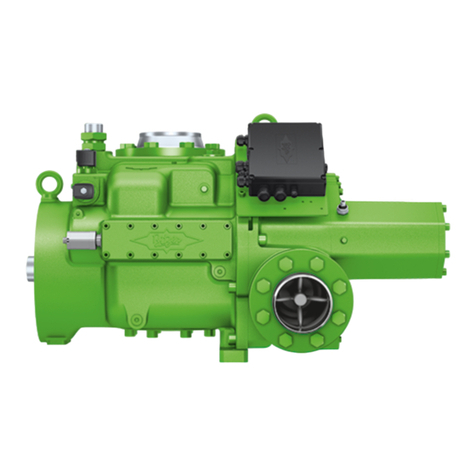
Bitzer
Bitzer OSKA9553 operating instructions

YATO
YATO YT-73460 instruction manual
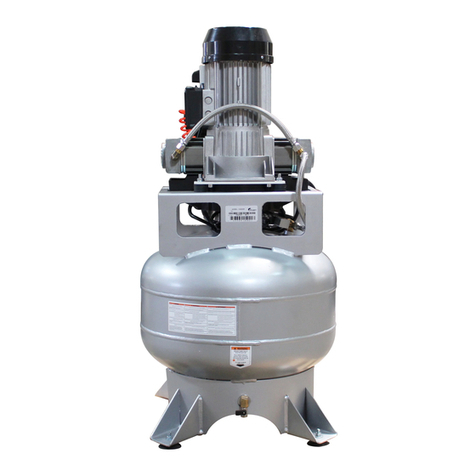
California Air Tools
California Air Tools 15020CR owner's manual

Frick
Frick RWB II 60 Installation operation & maintenance
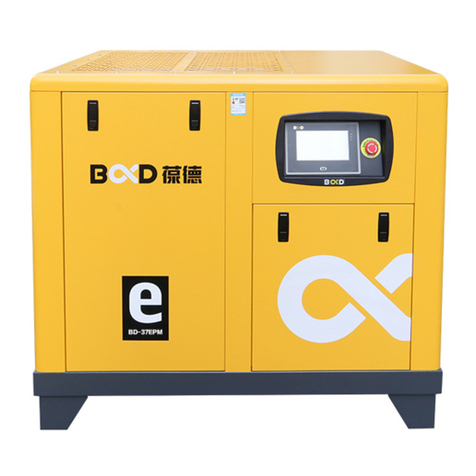
Baldor
Baldor BD Series user manual

ULTIMATE SPEED
ULTIMATE SPEED UMK 10 C2 Operation and safety notes translation of the original instructions
